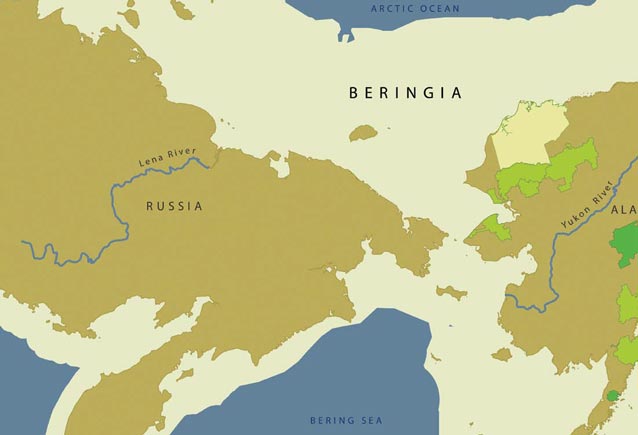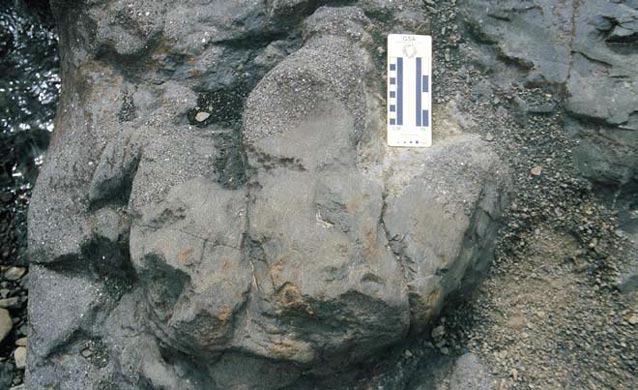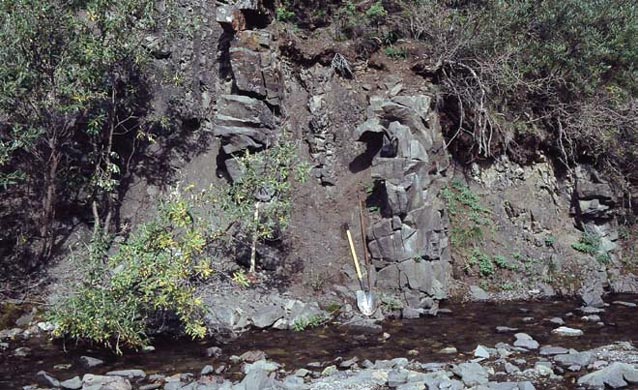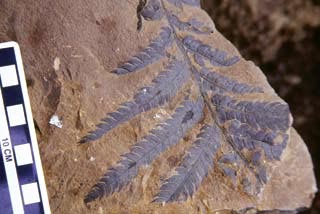
National Park Service units in Alaska contain some of the most informative fossil-bearing rocks anywhere in North America. These park units fall within the dynamic subcontinental region denoted by “Beringia,” the hypothesized land bridge connection between Asia and North America during the Plio-Pleistocene (Hultén 1937). By linking similar aged rock units in National Park Service lands with the fossil resources found on other federally-administered public lands, important paleoecological insights on specific ecosystems can be obtained. Here we provide summa-ries of how pertinent regions address the antiquity of terrestrial Beringian ecosystems, the implications of this antiquity, and uggest that the NPS–Alaska Region is ideally situated to adopt leading roles in exploration of this concept.
Role 1: Sites for field research on Cretaceous Beringia
Late Cretaceous rocks of Denali National Park and Preserve (Denali), Yukon-Charley Rivers National Preserve (Yukon-Charley), Wrangell-St. Elias National Park and Preserve (Wrangell-St. Elias), and the North Slope of Alaska provide some of the most significant opportunities to examine a regional ancient terrestrial ecosystem in detail. Additionally, paleontological work on similar aged rocks in southwestern Alaska in Aniakchak National Monument has shown that this ecosystem is recorded across the state (Fiorillo and Parrish 2004). This ecosystem supported a rich dinosaurian fauna as well as other fossil vertebrates such as mammals, birds, and fishes (Fiorillo 2006, Gangloff 1998). The floral component of this ecosystem also was diverse and included angiosperms, gymnosperms, and ferns.
The Cantwell Formation is an extensive rock unit exposed throughout much of Denali and is now known to contain thousands of fossil vertebrate footprints (Fiorillo et al. 2007, Fiorillo et al. 2009). The rock unit is thousands of meters thick and consists of an upper, dominantly volcanic unit and lower, dominantly fluvial unit. Pollen analysis for the lower Cantwell Formation shows the rock unit to have been deposited during the latest Cretaceous. Sedimentation was dominated by stream and lacustrine environments, at times with a marginal marine influence. The vegetation at the time was dominated by conifer forests, and a mosaic of angiosperms in the forest understory.
Unnamed rocks in Yukon-Charley have been mapped as Cretaceous-Tertiary in age based on fossil floral remains (Brabb 1965, Dover and Miyaoka 1988). The depositional environments of these rocks, like the Cantwell Formation, represent rivers and floodplains. Given that they may be similar in age to those in Denali they are included here. The forest of this park unit was dominated by Metasequoia. No dinosaur remains have been found in these rocks.

Museum of Nature and Science
Similar to Yukon-Charley, Wrangell-St. Elias also contains unnamed rocks of Cretaceous age (Richter 1976). Recent preliminary paleontological field work has now shown that these rocks contain multiple dinosaur footprint types attributable to predatory dinosaurs and herbivorous dinosaurs. Whereas forests dominated the landscape in other regions, the rocks of this park suggest that forest cover was limited and instead the vegetative cover was dominated by expansive fern prairies. The limited forest cover replaced by fern cover may have been the result of a more dynamic river system that flooded the landscape more frequently compared to any of the other regions.
NPS units containing a fossil vertebrate record discussed here are so far based solely on fossil footprints. By contrast, comparably aged rocks on the North Slope contain an abundance of fossil bones, mostly dinosaurian, with only a minor record of fossil footprints. These two types of records then provide independent means to test ecosystem hypotheses.
Florally, an abundant and diverse assemblage of pollen, spores, amber, algae, and other microscopic plant debris has been recovered from the North Slope. The vegetation for this region of Alaska during the latest Cretaceous was dominated by conifer forests across the coastal plain and a mosaic of broad-leafed deciduous forest in riparian areas. The understory probably consisted of ferns and smaller angiosperms.
The depositional environment for the Late Cretaceous dinosaur-bearing units was that of a low-energy alluvial coastal plain. The floodplain was wet, but water levels probably fluctuated from shallow standing water to dry and subaerially exposed, possibly on a seasonal basis.
Beringian ecosystems have fostered specializations of flora and fauna over time, as is especially evident among those vertebrates that leave abundant fossils. Striking faunal and floral structural parallels in ecosystems are manifest in the Cretaceous of this region. Current paleontological investigations on correlative fossil-bearing rocks in these three regions, combined with revised tectonic reconstructions of the region lead us to conclude that Beringia originated some 100 million years ago (Fiorillo 2008). This extension of Beringia back in time re-quires a reordering of the importance we assign to under-lying mechanisms. Atmospheric and oceanic phenomena remain important climate variables to explain the Quaternary changes in Beringia. Accepting Beringia’s origins in the Cretaceous, however, implies that Beringia is rooted in its accretionary rather than in its climatic history. In other words, tectonics has been the defining parameter for Beringia Paleoclimate data show that temperatures in the northern polar regions were significantly warmer during the Cretaceous compared to the modern data (e.g., Bar-rera and Johnson 1999). Studying ancient Beringia provides a unique opportunity to compare high latitude ecosystem dynamics under contrasting greenhouse and icehouse conditions.

Museum of Nature and Science
Role 2: Opportunities for synthesis of the Cretaceous origins of Beringia
The concept of Beringia as limited to the Plio-Pleis-tocene depends entirely on glacial advances and retreats to drive falls and rises in sea level. High sea levels facilitate exchanges of marine biota between the Pacific Ocean and Arctic Basin; lower sea levels enable terrestrial faunal and floral exchanges between Asia and North America. Recent advances in resolution of geochronologic methods show us that climate-driven sea level changes have been relatively recent and weak determinants of biogeographic patterns—the final epilogue to a Beringia story spanning 100 million years.
Some analysts convinced of Beringia’s Quaternary reality are still surprised to learn that Beringia’s influence on regional and circumarctic biogeography had begun by the early Tertiary. Pre-Quaternary connection of Asia to North America was acknowledged with the broad acceptance of plate tectonic theory (Hopkins 1967a, Cox 1974, Marincovich et al. 1990). Quaternary Beringia enjoys a 400-year head start over the concept of Mesozoic Beringia. A South American Christian missionary in 1590 first proposed that dry land connected northeastern Asia to the Alaskan tip of northwestern North America, to explain the peopling of the New World (O’Neill 2004). Not until 200 years later, at the end of the eighteenth century, had Vitus Bering’s and Captain James Cook’s voyages confirmed close physical, biological and cultural connec-tions between the two continents. About 150 more years passed before Hultén’s (1937) phytogeographic studies gave the subcontinental region a name and accelerated the subsequent proliferation of geological and biogeographic investigations (O’Neill 2004). After 50 more years, the dinosaur fauna of Arctic Alaska began to persuade analysts that Beringia’s global influence is immense, temporally as well as spatially.

Museum of Nature and Science
Hultén’s original concept was limited. He conceived of Beringia as the major ice-free refugium for terrestrial northern vascular plants being excluded and extirpated elsewhere by glaciers and continental ice sheets during glacial maxima. Since the mid-twentieth century, biogeographers and paleontologists have credited Beringia with additional functions in the diversification of biota over increasing spans of geological time in the Northern Hemisphere (cf. Abbott and Brochmann 2003, Sanmartín et al. 2001). Collectively, these scientific efforts remain compartmentalized and under-recognized across boundaries separating disciplinary specialties. Evidence from dinosaur paleontology in Alaska, however, suggests that reaffirming the Cretaceous underpinnings of Beringia can lead to a timely synthesis of ideas between biogeographers and geologists.
Viewing Beringia as rooted in the Cretaceous reminds us that details of current phenomena and of the more recent past blur into broader generalizations further back in time. Likewise, subtle taxonomic affinities and distinctions among extant biota are replaced by larger, more radical, taxonomic distinctions in the more distant past. The in-terdisciplinary challenge for paleontologists is nevertheless to remain conversant with the nuances that modern sciences bring to bear on understanding current biological systems.
A synthesis of disparate pieces of evidence for Beringia’s being a determinant of phenomena characterizing the Northern Hemisphere is likely to elude the efforts of disciplinary specialists until they are brought face to face in collaboration. The U.S. Geological Survey once carried out this facilitation (e.g., Hopkins 1967b), which clearly needs to be resumed. The NPS has a history of recognizing the significance of Beringia through its administration of the Shared Beringian Heritage Program. Given that much of the key geology defining the antiquity of Beringia falls within NPS boundaries, these NPS units are ideally situated for addressing fundamental questions regarding ancient ecosystem dynamics in deep geologic time.
References
Abbott, R.J., and C. Brochmann. 2003.
History and evolution of the arctic flora: In the footsteps of Eric Hultén. Molecular Ecology 12: 299-313.
Barrera, E., and C.C. Johnson, eds. 1999.
Evolution of the Cretaceous Ocean-Climate System. Geological Society of America Special Paper 332. Boulder, CO.
Brabb, E.E. 1965.
Field stations and fossil localities in the Eagle D-1 Quadrangle, East Central Alaska and adjoining Canada. United States Geological Survey, Open File Map 65-20, 1:63,360.
Cox, C.B. 1974.
Vertebrate palaeodistributional patterns and continental drift. Journal of Biogeography 1: 75–94.
Dover, J.H., and R.T. Miyaoka. 1988.
Reinterpreted geologic map and fossil data, Charley River Quadrangle, East-Central Alaska. United State Geological Survey, Miscellaneous Field Studies Map MF-2004, 1:250,000.
Fiorillo, A.R. 2006.
Review of the Dinosaur Record of Alaska with comments regarding Korean Dinosaurs as comparable high-latitude fossil faunas. Journal of Paleontological Society of Korea, 22(1): 15-27.
Fiorillo, A.R. 2008.
Cretaceous dinosaurs of Alaska: Implications for the origins of Beringia. In The Terrane Puzzle: new perspectives on paleontology and stratigraphy from the North American Cordillera, edited by R.B. Blodgett and G. Stanley. Geological Society of America Special Paper 442. Boulder, CO. 313-326.
Fiorillo, A.R., P.J. McCarthy, B. Breithaupt, and P. Brease. 2007.
Dinosauria and fossil Aves footprints from the Lower Cantwell Formation (latest Cretaceous), Denali Park and Preserve, Alaska. Alaska Park Science 6: 41-43.
Fiorillo, A.R., and J.T. Parrish. 2004.
The first record of a Cretaceous dinosaur from western Alaska. Cretaceous Research 25: 453-458.
Fiorillo, A.R., S.T. Hasiotis, Y. Kobayashi, and C.S. Tomsich. 2009.
A pterosaur manus track from Denali National Park, Alaska Range, Alaska, USA. PALAIOS 24(7): 466-472.
Gangloff, R.A. 1998.
Arctic dinosaurs with emphasis on the Cretaceous record of Alaska and the Eurasian-North American connection. In Lower and Middle Cretaceous Terrestrial Ecosystems, edited by S.G. Lucas, J.I. Kirkland, and J.W. Estep. New Mexico Museum of Natural History and Science Bulletin No. 14. 211-220.
Hopkins, D.M. 1967a.
The Cenozoic history of Beringia-A synthesis. In The Bering Land Bridge, edited by D.M. Hopkins. Stanford University Press. Stanford, CA. 451-484.
Hopkins, D.M. (ed). 1967b.
The Bering Land Bridge. Stanford University Press. Stanford CA.
Hultén, E. 1937.
Outline of the history of Arctic and Boreal biota during the Quarternary period. Strauss und Cramer. Germany. Reprint of the Stockholm edition.
Marincovich, L., Jr., E.M. Brouwers, D.M. Hopkins, and M.C. McKenna. 1990.
Late Mesozoic and Cenozoic paleogeographic and paleoclimatic history of the Arctic Ocean Basin, based on shallow-water marine faunas and terrestrial vertebrates. In The Arctic Ocean region, The Geology of North America, vol. L, edited by A. Grantz, L. Johnson, and J.F. Sweeney. Geological Society of America. Boulder, CO. 403-426.O’Neill, D. 2004. The last giant of Beringia: The mystery of the Bering land bridge. Basic Books/Perseus. New York.
O’Neill, D. 2004.
The last giant of Beringia: The mystery of the Bering land bridge. Basic Books/Perseus. New York.
Richter, D.H. 1976.
Geologic map of the Nabesna Quadrangle, Alaska. United States Geological Survey. Miscellaneous Investigations Map I-932, 1:250,000.
Sanmartín, I., H. Enghoff, and F. Ronquist. 2001.
Patterns of animal dispersal, vicariance and diversification in the Holarctic. Biological Journal of the Linnean Society 73: 345-390.
West, F.H. (ed.). 1996.
American beginnings: The prehistory and palaeoecology of Beringia. University of Chicago Press. Chicago.
Part of a series of articles titled Alaska Park Science: Volume 8, Issue 2: Park Science in the Arctic.
Last updated: October 26, 2021
